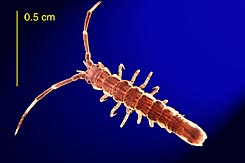Q. What is forensic ecology ?
A. Knowledge of the ecology, biology, physiology and behaviour of organisms in different communities enables us to provide important evidence. For example, whether or not a particular operation is responsible for an environmental impact, where a sample originated, prevailing environmental conditions and, very importantly, sequences of events
Q. Does Physalia only work for regulatory authorities ?
A. No, we work for industry, the legal profession, private concerns and, on some occasions, for individuals and the media
Q. Where is Physalia located ?
A. Originally based in London, we are now situated in Hertfordshire, England, and also have facilities in Madrid, Spain, with our sister company, Nebalia S.L. Consultorķa Medioambiental
Q. What background is needed to become a forensic ecologist ?
A. A good grounding in taxonomy is essential. Without this, fundamental errors can be made in interpreting prevailing conditions, in determining the original sources of organisms present in samples and in predicting the likely effects that different types of stresses and disturbances will exert. In reality, ecology is secondary to this, although without an understanding of the interactions between plants and animals and the physico-chemical conditions in their environment, many of the applied aspects of our work could not be undertaken
Q. What types of pollution or stresses can meiofauna be used to assess ?
A. It may sound too good to be true, but meiofanal analyses have proved to be valuable to our customers in nearly all our contaminant monitoring studies worldwide. They are extremely abundant and highly diverse in terrestrial and aquatic environments and include species that are the last to disappear as conditions deteriorate and the first to reappear conditions improve again. Their community structures have allowed us to examine and describe physical disturbance, changes in nutrient status, changes resulting from altered freshwater flows from catchments due to drought conditions and/or increased water abstraction (e.g. in the Thames estuary, England) and to monitor and assess prevailing environmental conditions in sites contaminated with heavy metals, trace metals, metalloids and a spectrum of organic compounds including PAHs, halogenated hydrocarbons (PCBs, CHCs and pesticides) as well as oils + petrochemicals and their derivatives. Analysing combined meiofaunal community and contaminant data also allows our statisticians to identify the compounds that exert the greatest ecological impacts and then to rank these in terms of their actual ecological actual significance
Q. Does Physalia provide any training courses ?
A. Yes, we provide a variety of tailor-made courses, including in situ courses for industry and regulators and residential courses with lectures held in a listed Elizabethan Manor House


